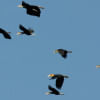The Hornbill

Hornbills, according to Scientific American, are “among the most charismatic, fascinating and awesome of birds” and are “incredibly elusive.” There are about 60 species of hornbills spread around Asia and Africa. While hornbills have several physical features worthy of note, their highlight is the casque: a cylindrical appendage over a huge curved beak that makes them look like no other bird.
Three species of hornbill can be seen in Bangladesh: great hornbill, wreathed hornbill and oriental pied hornbill. All are found in our forests, but the first two are extremely rare. The pied hornbill is a bit easier to find. Still, in many trips I have made to our national forests, the closest I came to seeing one was years ago at Kalenga Forest when I saw parts of a black head and wings of a large bird peeking from behind leaves. It disappeared quickly. Since then, hornbills have been far from my realistic expectations.
So you can understand my scepticism when my guide, Abdur Rahim, told me - as I arrived at Satchori National Park in Habiganj - that he had a “feeling” we might see a dhonesh.
We entered the park around 9 a.m. and headed to the watchtower. Sometimes there are good views of unusual birds here and we were not disappointed today: a splendid hair-crested drongo, with a thin but flowing crest of hair over its head and iridescent blue chest feathers gave us a good start. A scarlet minivet also showed up, albeit a bit far. Then there was silence: no more birds. We waited fifteen minutes before heading down and into the forest.
Birding inside the forest was also unproductive. We saw many common red-vented bulbuls as well as a few bee-eaters, but nothing special. At one point I saw woodpeckers in the distance, and one flew to a tree close by. But it disappeared among the leaves before I could point my camera at it.
An hour later, my patience running out, I asked Rahim to take me to a spot where I had luck earlier. Reaching there, Rahim spotted a black baza in the distance. It flew away as soon as we arrived. We patiently stood waiting for it to reappear when out of nowhere a large bird landed on a tree nearby. Rahim spotted it first: an oriental pied hornbill!
It was sitting with its back towards us, but it occasionally turned its head and I could see its famous beak and casque. After a few minutes it flew and sat on a wild fig tree, eating the fruit. Between munching, it preened its feathers.
We followed it for almost an hour as it perched on three other trees. Its movements were slow and deliberate as it scanned the trees for fruits, its main food. It twisted and curled its long neck while reaching for fruit with its long beaks. This frugivore also eats smaller insects and rodents.
Hornbills are little understood. Because of their voracious appetite for fruits (and thus spreading seeds) they are called Farmers of the Forest. Their sexual dimorphism (difference between male and female physique) can be spectacular, with males being over twice the size of females. Some hornbills can live for 70 years.
Why the casque? Some think it is a sign of adulthood, while other evidence suggests it strengthens the beaks which can then be used more forcefully.
As my time ran out, I took some last photographs of hornbill before leaving the forest, vowing to return for this splendid creature.
www.facebook.com/ikabirphotographs or follow ihtishamkabir on Instagram

 For all latest news, follow The Daily Star's Google News channel.
For all latest news, follow The Daily Star's Google News channel. 




Comments